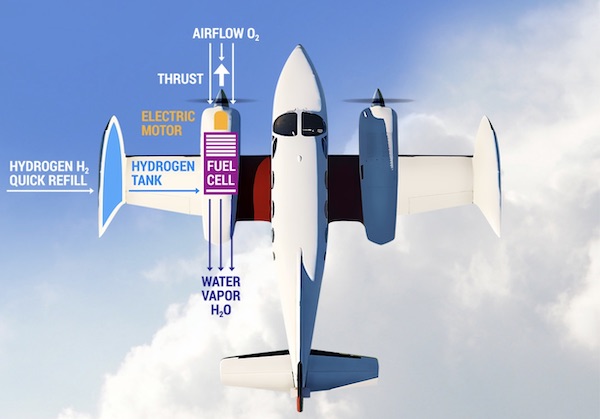An Historic Hydrogen Outing
While Airbus and MagniX promote the near- and not-so-near virtues of hydrogen-powered flight, ZeroAvia has demonstrated such flight with the largest H2-powered aircraft so far. Their Cranfield, England-based Piper Malibu flew on H2 power for the first time September 24 on an eight-minute circuit. The blue Malibu reached 1,000 feet and a top speed of 100 knots true air speed.
Quick to capitalize on the successful mission, , ZeroAvia founder and CEO Val Miftakhov held a press conference the next day. In it, he explained his team,“has had discussions with seven aircraft manufacturers about possible retrofit and new-build applications for the propulsion system. He said the company has signed letters of intent with 10 airlines that have expressed an interest in the program based on presentations made to around 30 different prospective operators.”
Earlier flights in Hollister, California and Cranfield were battery powered “to evaluate different elements of the powertrain.” Unspecified modifications helped prepare the craft for the short hydrogen flight.
With only a few months left in the year, ZeroAvia has announced plans to make a flight of up to 300 nautical miles (345 statute miles) by the end of 2020. The craft, with “full propulsion system” will fly from the Island of Orkney, which has a hydrogen production plant, to the UK mainland.
ZeroAvia intends to do even more and quickly, intending to obtain a type certificate by the end of 2023 to retrofit a 10- to 20-seat aircraft. The plane, along the lines of a Cessna Caravan, their new SkyCourier, a DeHavilland Twin Otter or Dornier 228, would carry enough hydrogen to go 500 nm (575 statute miles).
Miftakhov looks ahead to his systems powering a 50- to 100-seat aircraft in commercial service by 2030, H2 could be flying 200 passengers up to 3,000 nm (3,452 statute miles) by 2040. Similar to plans by MagniX, DeHavilland Dash 8s and ATR42s are potential interim airframes for conversion to H2 power.
Working with the UK Civil Aviation Authority, ZeroAvia will increase the Malibu’s hydrogen storage capacity and increase the motor’s power from 230 kW (308 hp) to 260 kW (349 hp). This will probably keep Gabriel DeVault, the company’s head of drivetrain development, busy for the next few months.
Tricky Politics Ahead
ZeroAvia won a September 2019 award of £2.7 million ($3.4 million) from the UK government through its Aerospace Technology Institute (ATI) under its HyFlyer project. This is an early step in the government’s plan to achieve zero carbon air transportation by 2050. The successful Malibu flight was witnessed by UK business and industry minister Nahdim Zahawi and aviation minister Robert Courts. Their comments can be found in ZeroAvia’s press release for the event.
Because the UK is exiting the European Union, certain aspects of aircraft certification may become a bit jumbled in the process. “Miftakhov acknowledged that it is still uncertain how a UK-based company will be able to navigate the EASA (European Union Aviation Safety Agency) certification process at the end of the Brexit transition period on December 31, 2020.” Existing rules of reciprocity among Union nations may continue to apply to a former member country, but nothing seems to be engraved just yet.
Support from Government and Industry Partners
Several government and industry partners provide support for ZeroAvia and its HyFlyer program. Two well-established operations, the European Marine Energy Center (EMEC) and fuel-cell developer Intelligent Energy, provide hydrogen and a Hydrogen Airport Refueling Ecosystem at Cranfield. This ground-based setup will demonstrate its capabilities while the Malibu demonstrates H2’s capabilities in the air.
When the hydrogen-fueled flight from Orkney succeeds, true cross-country flight in emissions-free aircraft will promote a new perspective for green aviation. Beyond that, expansion of a green hydrogen infrastructure will benefit all of transportation.

